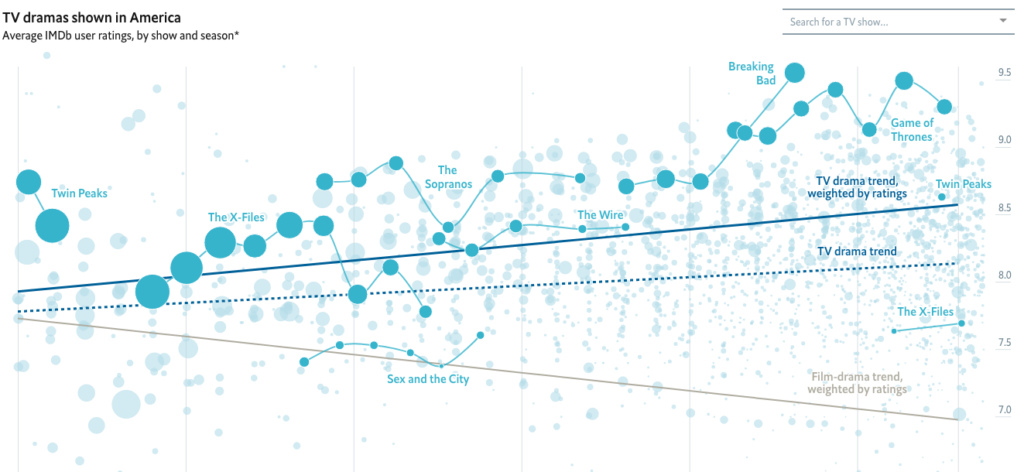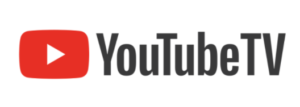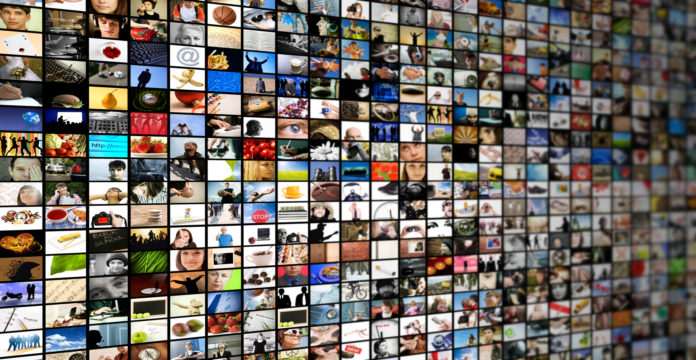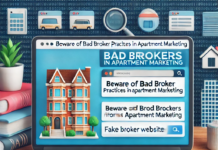Are we in the golden age of TV or the golden age of streaming? Or, does the transition to TV streaming enhance and increase the longevity of TV’s golden age? There are so many questions (and corresponding think pieces) about the streaming wars, the best streaming devices and what platform has the best programming. Ultimately, as consumers, are our interests aligned with any platforms? How do we determine where (or if) streaming is right for our entertainment? There are so many questions (and likely not enough solid answers), but we are here to help sort it out and review the best TV streaming services.
The Golden Age of TV Welcomes the Wacky World of TV Streaming
Welcome to the age of TV! As all of the recent think pieces proudly share, we are currently living in the golden age of TV. Generally believed to have started with The Sopranos in 1999, the quality and quantity of well received television shows has flourished over the last few decades.
However, are we really living in the golden age of TV? Yes and no.

Recently, The Economist reviewed the ratings of this golden programming and determined, once again, the gift and curse of living in the internet age. In summary, there are more shows, which means more good and bad shows. However, the streaming services leverage software recommendations, so we see more of the shows that we want to watch. As a result, yes, we all believe we are in the golden age of TV!
“Fortunately for audiences, streaming platforms make avoiding such duds far easier. These services’ recommendation systems guide viewers to content they are likely to enjoy. Sure enough, the highest-rated shows now get the most reviews. From 1993 to 2013, the average IMDB rating of a typical show rose by just 0.26 points. But the average weighted by the number of ratings climbed much more, by 0.89 points. That suggests viewers are finding shows they like far more often today than in the past.”
The Transformation of TV Streaming Services
Generally speaking, the age of TV streaming services kicked off in the mid-2000s when Netflix, YouTube and Hulu hit the market. These platforms leveraged the “on-demand” movement of traditional cable TV and consumers got a taste of watching what they want when they want it. Now, we are about to enter the depths of the streaming wars as consumer demand is taking its toll on the cable industry.
For example as we close out 2019 and head into 2020, Slate highlighted the transformation in consumer entertainment demand.
“In the next several months, you’ll be able to access more content on your TV and TV-shaped devices than ever before. Apple TV+ launches this week with a glitzy, high-profile lineup of new shows—Jen! Reese!—and many more to come. In a matter of days, you’ll be able to log on to Disney+ and kick back with a $100 million addition to the Star Wars universe as well as a new version of Lady and the Tramp. But we’re just getting warmed up. Next April, NBCUniversal will launch its own streaming service called Peacock with a Battlestar Galactica reboot from Mr. Robot’s Sam Esmail as well as a reboot of Saved by the Bell, and it will be followed in May by HBO Max, which announced more than a dozen new series, including a long-anticipated Game of Thrones prequel, this week. If Peak TV is actually going to peak, it’s not happening anytime soon.”
As they say, if you build it, they will come, but in the case of TV streaming, the cable companies continue to chase the consumers. For example, eMarketer conducted a study in 2018 that projected by 2022, cord-cutters will amount to over 21% of the U.S. population (up from 15% in 2018). Additionally, the study indicated that the growth in streaming platforms is directly tied to the loss of pay-TV consumers. As a result, cable channels and pay-TV providers must adapt and find ways to include streaming into their business models.
What is driving the consumer adoption of streaming services? Content and cost! The daily financial newsletter, Morning Brew, summed up the transformation to streaming.
“The content on streamers’ platforms got better and better—and prices were a bargain compared to cable—so consumers started to cut their cords. This trend has accelerated faster than analysts expected.”
The Best TV Streaming Services For Your Entertainment Needs
In addition to convenience and cost, another major reason streaming services continue to flourish is content. And it’s not sure pure amounts of content (which does help), it is access to desirable content. As a result, the best TV streaming services offer unique content for everyone. (Which does mean a massive amount of content is needed.)
So, how does someone determine the best TV streaming service for them? To help, we look at the major streaming platforms and review the pros and cons of each service.
-
The Game Changer: Netflix Streaming

Netflix changed the streaming game in the mid-2000s by building an exhaustive slate of programming. As streaming services compete on content, Netflix remains the game changer because the platform continues to combine new and old titles that attract a vast array of viewers. For example, PC Mag shares an analysis of Netflix content.
“It hosts an impressive selection of content at all times, with new titles exchanged for older ones monthly. And then there’s Netflix constantly growing library of premier original programming, which still outclasses every other streaming service. Netflix’s impressive catalog includes shows such as Altered Carbon, Black Mirror, Bojack Horseman, Dead to Me, Mindhunters, Orange is the New Black, Russian Doll, Stranger Things, The Crown, The OA, The Umbrella Academy, and Unbelievable.”
However, Netflix does not offer live TV, which is increasingly becoming part of the streaming service package. For consumers looking to cut the cord, then Netflix does not provide an option to watch current or live TV programs.
Additionally, as the competition ensues and additional streaming platforms hit the market, some of the tried and true Netflix content is moving to other platforms. For example, Friends and The Office will no longer be staple titles in the Netflix arsenal. Fortunately, Netflix remains dedicated to producing unique content and spends millions of dollars annually on creating new content.
Ultimately, consumers can remain confident that Netflix will continue to offer a vast array of high quality content for lovers of all types of entertainment.
-
The Conglomerate: Hulu

Hulu, which was originally created by a conglomerate of entertainment and media companies, is now owned by The Walt Disney Company and Comcast. As a result, Hulu offers viewers with a large of amount of programming, plus the option to watch live TV! For example, CNET explains what this means for consumers (both the pros and cons).
“With the least cable-like interface of its competitors, Hulu’s greatest asset is the integration of live TV with its significant catalog of on-demand content for one price. Unfortunately, the interface frustrations apparent with the standard service are amplified once you add live TV. Another issue is that you’ll have to pay another $10 per month to get the ability to skip commercials on Hulu’s cloud DVR (the base cloud DVR, which is included, doesn’t permit skipping ads). Its channel count is solid, however, and with Hulu’s catalog included it’s a top competitor.”
As opposed to Netflix, Hulu does offer live TV (although at a much higher price point than simple streaming). However, Hulu offers viewers with plenty of entertainment options, which includes current programming (but not in real time). Finally, Hulu also supports third party channels, like HBO or Showtime, so consumers can use Hulu as the core of their entertainment needs.
Finally, Hulu recently completed a redesign of the user interface. As a result, consumers now have consistency across platforms (mobile, tablet and PC) and enabled premium users the ability to download content for offline viewing. For consumers looking to take the plunge with Hulu should note that as Disney is the primary owner of the streaming platform, watch for updates on Disney + and any impact on the Hulu offering.
-
The Content King: Amazon Prime Video

Amazon Prime Video quickly become a leading streaming service by leveraging the power of Amazon Prime. For example, Prime members automatically receive access to Prime Video. Additionally, Prime Video leveraged the funding from Amazon, so the service was quickly able to generate perhaps the largest amount of content in the streaming market. As a result, Amazon offers a combination of original content with TV programming.
“In recent years, Amazon has focused on curating a wide range of original shows, such as Bosch, Catastrophe, Fleabag, The Man in the High Castle, The Marvelous Mrs. Maisel, One Mississippi, Patriot, Red Oaks, The Boys, The Grand Tour, and Undone. Many of these shows are excellent and on par with Netflix’s offerings, though the latter has a much deeper content library. Prime Video also hosts top shows from other networks, including HBO, at no additional cost, though you can add a Prime Channel subscription to your account for full access to the libraries of HBO, Starz, Showtime, CBS All Access, and Cinemax. Amazon’s video library also includes tons of popular movies available for streaming at no additional cost. Users have the option to purchase or rent movies and TV shows as well, similar to Apple’s iTunes, Google’s Play Movies and TV Shows, and Microsoft Store’s Movies and TV section.”
As a result of the Amazon flywheel (Prime Video keeps customers in the Amazon ecosystem, which translates to more e-commerce sales) means Amazon has plenty of money to compete with other streaming services. This matters because Amazon does not offer live TV, but tests and may look to enter the live sports market. Live sports remains one of the most expensive contracts in entertainment because viewers watch in real time, which means advertisers pay up for TV spots. Most streaming services do not have the money to compete with traditional media companies, but Amazon does, so consumers should feel comfortable knowing Prime Video options will only expand over time.
-
The New Content King: Disney+

Disney+ launched late in 2019 and instantly become a powerhouse in the streaming wars. Based on the enormous amount of content in the Disney library, the platform jumped to one of the best TV streaming services. Additionally, Disney+ hit the market at the low end of monthly subscription fees ($7 per month or $70 per year). For consumers, particularly with young children, Disney+ answers the call for great content at a low price. And expect that content to grow over time!
“Disney+ packages a ton of Disney’s media properties, including from Pixar, Marvel, Star Wars, and National Geographic, in to a full-featured streaming service. In addition to classic Disney content, you can also watch originals such as Encore!, High School Musical: The Musical: The Series, Marvel’s Hero Project, The Mandalorian, and The World According to Jeff Goldblum. Upcoming original productions include Loki (and several other Marvel titles), Monsters at Work, and Timmy Failure. Note that some entries from Disney franchises as well as most content it acquired from its 21st Century Fox takeover are currently missing from the service, likely due to existing licensing agreements. However, expect Disney+’s library to grow over time as it reclaims titles.”
The Walt Disney Company is an enormous media conglomerate (remember, the company also owns a majority of Hulu), so the Disney+ offering can compete directly with any streaming platform. Additional, Disney can help offset the monthly costs (like Amazon) because the company generates revenue from other business lines, such as merchandise and theme parks!
Ultimately, the current iteration of Disney+ lacks live TV, a bundled plan (for $13 per month) also includes Hulu and ESPN+, which provides access to current TV programming. Additionally, Disney aims to launch new original programming and movies to the platform, including content from the leading studios such as LucasFilms, Marvel Studios and Pixar.
-
The Distributor: Apple TV+
![]()
Similar to Disney+, when Apple launched Apple TV+, the platform immediately had a distribution edge. Across the world, billions of Apple devices are in the hands of people dedicated and devoted to the brand. As a result, Apple TV+ can instantly leverage this distribution with a low monthly price point ($5 per month) to offer content around the world.
“However, the amount of content right now is limited because the service launched with just nine new originals, and unlike many other services, Apple lacks a robust catalog of shows. Among the available shows are “The Morning Show,” about a morning talk show, starring Reese Witherspoon, Jennifer Aniston, and Steve Carell; “See,” a post-apocalypse drama starring Jason Momoa and Alfre Woodard; “For All Mankind,” a series that imagines what would have happened if the global space race had never ended; and “Dickinson,” a coming-of-age story from the perspective of Emily Dickinson. Apple TV+ also has a subscription option, called Apple TV Channels, for Apple TV users. It makes it easy for them to subscribe to channels such as HBO and Showtime from a single app.”
As expected, Apple offers a seamless viewing experience. However, and this is a good thing for consumers, Apple opened the platform to non-Apple devices. For example, viewers can watch original programming on Samsung TVs, along with Amazon Fire TV, LG, Roku, Sony, and Vizio. Previously, any Apple content required an Apple TV to watch.
Finally, like with most streaming services, Apple lacks live TV, but as Apple focuses on design, the UI offers an excellent streaming experience. However, upon launch, Apple TV+ requires some work to truly be discussed among the best TV streaming services.
-
The Original King of Content: HBO
![]()
HBO has provided quality content for decades and gradually adapted to the world of streaming. The high quality content is available through subscription via HBO Go, but HBO Max will hit the public in May 2020. Currently, HBO Go is for current subscribers, while HBO Max will offer consumers with the WarnerMedia platform of entertainment options. Additionally, HBO offers HBO Now, which is a standalone streaming service. According to HBO, subscribers to HBO Now will also receive access to HBO Max under the same subscription. For more, HBO provides some explanation behind the various tiers.
“HBO NOW is a standalone streaming service offered by HBO that does not require cable or satellite TV and offers original content from HBO, including series, documentaries, specials and more, plus a large selection of movies. Current HBO NOW subscribers (billed directly by HBO) will also get access to HBO Max at launch at no additional cost. HBO Max is a platform offered by WarnerMedia that features 10,000 hours of premium content bundling all of HBO together with even more movies, shows and Max Originals for the whole family, including Friends, South Park, The Big Bang Theory, Wonder Woman, the Studio Ghibli collection and much more.”
HBO offers consumers with high quality content and continuously wins awards for their original programming. With HBO Max, one of the selections will provide a vast catalogue of content that was not available under the standalone HBO service. Additionally, HBO Now works with many of the streaming devices, such as Roku, Amazon Fire TV, Chromecast and more, which means the content should be streamed for everyone. For any movie buffs or entertainment gurus, HBO offers one of the best TV streaming services for premium content on the market.
-
The Forgotten Giant: YouTube TV

YouTube revolutionized the streaming market. However, many people forget about the platform as a place of unique and original content. We mainly think of YouTube for music and how-to videos, but it offers much more. YouTube TV provides consumers with a replacement to traditional cable subscriptions.
“YouTube TV features a collection of over 70 channels, which stacks up well against the competition. In fact, it offers one of the most complete channel lineups of all the video streaming services on the market. Starting with the locals, you get all the major networks such as ABC, CBS, Fox, and NBC. News channels include ABC, BBC America, CNBC, CNN, Fox News, and MSNBC.”
For families looking to cut the cable bundle, then YouTube TV offers a vast selection of channels at a relatively modest price point. The streaming service provides all of the local and national sports channels that are “must haves” for most folks. Additionally, the subscription includes the major “reality” TV channels that ensures the plan includes something for everyone. For people looking to add-on to their entertainment stack, then this streaming service is not the best option as it mirrors programming available on standard cable without many original programs.
-
The Broadcaster: Peacock

NBC Universal, which owns and operates NBC, along with other popular channels unveils Peacock in July 2020. Backed with the ownership rights to lots of popular content, such as Parks & Recreation and The Office, Peacock will remove some high profile shows from competing streaming platforms and retain those viewership rights solely for their own network. Additionally, Peacock will introduce new original programs, which makes the streaming service one of the most comprehensive options on the market.
“Peacock will launch with 15,000 hours of content, including The Office, Parks & Recreation, and revivals of several old favorites. Expect ad-supported and subscription tiers, though exact pricing has not been announced. NBC is also bankrolling a number of other scripted and unscripted originals, including an adaptation of the Dr. Death true crime podcast starring Alec Baldwin and Christian Slater, a new comedy called Rutherford Falls starring Ed Helms, and another called Straight Talk with Rashida Jones and Jada Pinkett Smith.”
Peacock bills itself as the best of streaming meets the best of TV, which makes sense based on the available content NBCU owns. Presumably, the streaming service aims at maintaining its core presence in the content bundle of any family, but pricing and usability remain to be seen. However, if a free ad-supported tier exists, Peacock will make a welcome addition for any streaming bundle.
-
The Telecom Giant: AT&T Now

AT&T Now, which was previously known as DirecTV Now, competes in the cable replacement tier of streaming services. As a result, AT&T Now enables for up to 3 simultaneous streamers, along with multiple tiers that start with 45 channels and DVR storage. Additionally, AT&T Now offers some add-on programs for those premium channels. The streaming service includes the basics and features that make it family friendly.
“AT&T TV Now offers 20 hours of DVR storage for free and keeps those recordings for up to 30 days, but most other services let users save more hours of programming and for longer. The service supports simultaneous streaming on up to two devices, which is about average, though you can pay an additional $4.99 per month to increase that limit to three devices. AT&T TV Now is available on a decent range of platforms including media streaming devices, mobile platforms (via the AT&T TV app), and the web, but is not available on either the Xbox One or PlayStation 4 consoles.”
For all the options that AT&T Now offers, the basic price points are a bit higher than the features provided. Plus, many of the competing tiers of cable replacements (such as Hulu with Live TV) also include original programming. But, for small families that do not require a vast catalogue, the simultaneous streaming over multiple devices may work and provide the best TV streaming service for your needs.
-
The Original Streamer: Sling
 Not to be confused with Slingbox, which mirrored cable subscriptions over the Internet, Sling TV, provides a true cable replacement streaming service. Founded in 2015 and a subsidiary of the Dish Network, Sling TV, offers a selection of prominent channels that we all know and love and stream that content via multiple types of devices.
Not to be confused with Slingbox, which mirrored cable subscriptions over the Internet, Sling TV, provides a true cable replacement streaming service. Founded in 2015 and a subsidiary of the Dish Network, Sling TV, offers a selection of prominent channels that we all know and love and stream that content via multiple types of devices.
“SLING TV L.L.C. is an Emmy® Award-winning live streaming TV service that provides more than 700 channels from today’s most popular networks across its general market, Latino and international services. It is available on all major streaming devices, smart televisions, tablets, game consoles, computers and smartphones. SLING TV offers two general market streaming services, SLING Orange and SLING Blue, that collectively feature content from Disney/ESPN, Fox, NBC, NFL Network, AMC, A&E, AXS, Discovery, Scripps, Turner, Viacom, NBA TV, NHL Network, Pac-12 Networks, GSN, Hallmark, SHOWTIME, STARZ and EPIX. On select devices, SLING TV offers customers access to free content, à la carte channels and services, plus Pay-Per-View events and movies on-demand. Additionally, SLING TV offers a suite of stand-alone and add-on Spanish-language services and packages tailored to English-dominant, bilingual and Spanish-dominant U.S. households. SLING TV is the leading U.S. provider of foreign-language programming, with more than 400 channels in 27 languages.”
At its core, Sling TV targets cord-cutters, which makes this one of the best TV streaming services on the market for individuals or families. The service starts at a low price point that includes most of the popular channels (including broadcast TV options) and the add-on prices for premium channels or entertainment bundles (like sports or Hollywood) helps elevate Sling TV as an option worth vetting.
Ultimately, consumers should feel comfortable with multiple platforms because it is unlikely that any service will meet all of your entertainment needs. The best TV streaming services offer an array of programming and the optionality for customization so it meets your needs.





